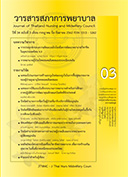Factors Predicting Trauma Patients’ Discharge Destinations
Keywords:
injury, physiological deterioration, pain, discharge destination, trauma unitAbstract
Objective: To study the predictive power of the factors of age, comorbidity,
physiological deterioration and pain on trauma patients’ discharge destinations.
Design: Predictive correlational design.
Methodology: This study was conducted on a sample of 300 trauma patients treated at the trauma unit of a campus hospital between January and June 2018. The research instruments consisted of 1) a personal information form; 2) the Modifed Early Warning Sign (MEWS) scale; 3) the Critical-Care Pain Observation Tool
(CPOT); 4) a comorbidity form; and 5) a discharge destination record form. The data were analysed using Point-Biserial Correlation and Logistic Regression Analysis.
Results: More than half of the subjects (58%) were males. The subjects’ average age was 48.58 years (SD = 19.86), about one-third (30.67%) of whom were injured in traffc accidents. Almost 75% of the subjects showed minor physiological deterioration, at an average of 2.01 (SD = 1.54) on the MEWS scale, and an average score of 2.47 (SD = 1.63) on the CPOT. Nearly half of the subjects (47.33%) had comorbidity conditions.
A predictive analysis showed that physiological deterioration and increase in pain frequency signifcantly raised the likelihood of the patients’ needing prolonged hospitalisation (.05 (OR = 2.23, 95% CI: 1.69-2.94; OR = 1.25, 95% CI: 1.06-1.49, respectively). These two factors were jointly capable of predicting 31.00% (Nagelkerke R2 = .31, p < .05) of the cases.
Recommendations: It is suggested that nurses and healthcare personnel apply physiological deterioration and pain data to the process of determining whether a patient needs continued intensive care or can be transferred to an in-patient ward.
Downloads
References
an overview of pathophysiology and treatment. Lancet 2014 October; 384(9952): 1455–65. doi:
10.1016/S0140-6736(14)60687-5.
2. American College of Surgeons Committee on Trauma. Advanced trauma life support for doctors. 9thed. Chicago:
American College of Surgeon. 2012. p. 6.
3. Nanjayan SK, John J, Swamy G, Mitsiou K, Tambe A, Abuzakuk T. Predictors of change in “discharge
destination” following treatment for fracture neck of femur. Injury 2014;45(7):1080-4. doi:10.1016/ j.injury.2014.02.005.
4. Morrison RS, Magaziner J, McLaughlin MA, Orosz G, Silberzweig SB, Koval KJ, et al. The impact of postoperative pain on outcomes following hip fracture. Pain 2003;103(3):303-11. doi:10.1016/S03
04-3959(02)00458-X.
5. Delgado-Hurtado JJ, Berger A, Bansal AB. Emergency department Modifed Early Warning Score association
with admission, admission disposition, mortality, and length of stay. J Community Hosp Intern Med Perspect 2016;6(2):31456. doi:10.3402/jchimp.v6.31456.
6. Dundar ZD, Ergin M, Karamercan MA, Ayranci K, Colak T, Tuncar A, et al. Modifed Early Warning
Score and VitalPac Early Warning Score in geriatric patients admitted to emergency department. Eur J Emerg Med 2016;23(6):406-12. doi:10.1097/MEJ.0000000000000274.
7. Rocha TF, Neves JG, Viegas K. Modifed Early Warning Score: evaluation of trauma patients. Rev
Bras Enferm 2016;69(5):906-11. doi:10.1590/ 0034-7167-2015-0145.
8. Alavi NM, Aboutalebi MS, Sadat Z. Pain management of trauma patients in the emergency department:
a study in a public hospital in Iran. Int Emerg Nurs 2017;33:53-8. doi:10.1016/j.ienj.2016.10.005.
9. Wuhrman E, Cooney MF. Acute pain: assessment and treatment. Topics in Advanced Practice Nursing
e-journal. 2011 Jan 3. (cited 2018 Jul 22). Available from: https://www.medscape.com/viewarticle/
735034
10. Silva EJ, Dixe MD. Pain prevalence and characteristics in patients admitted to a Portuguese hospital. Revista
Dor 2013;14(4):245-50.
11. Campbell-Furtick M, Moore BJ, Overton TL, Laureano Phillips J, Simon KJ, Gandhi RR, et al. Post-trauma
mortality increase at age 60: a cutoff for defning elderly? Am J Surg 2016;212(4):781-5. doi:10. 1016/j.amjsurg.2015.12.018.
12. Joseph B, Pandit V, Zangbar B, Kulvatunyou N, Hashmi A, Green DJ, et al. Superiority of frailty over
age in predicting outcomes among geriatric trauma patients: a prospective analysis. JAMA surgery
2014;149(8):766-72. doi:10.1001/jamasurg. 2014.296.
13. Chandra A, Crane SJ, Tung EE, Hanson GJ, North F, Cha SS, et al. Patient-reported geriatric symptoms
as risk factors for hospitalization and emergency department visits. Aging Dis 2015;6:188-95. doi:org/10.14336/AD.2014.0706.
14. Barnett K, Mercer SW, Norbury M, Watt G, Wyke S, Guthrie B. Epidemiology of multimorbidity and
implications for health care, research, and medical education: a cross-sectional study. The Lancet. 2012;380(9836):37-43. doi:10.1016/S014 06736(12)60240-2.
15. Bell TM, Zarzaur BL. The impact of preexisting comorbidities on failure to rescue outcomes in nonelderly trauma patients. J Trauma Acute Care Surg 2015;78(2):312-7. doi:10.1097/TA. 0000000000000467.
16. Calvo RY, Lindsay SP, Edland SD, Macera CA, Wingard DL, Ohno-Machado L, et al. The differential associations of preexisting conditions with trauma-related outcomes in the presence of competing risks. Injury 2016;47(3):677-84. doi:10.1016/j.injury.2015.10.055.
17. Anwar K.Pathophysiology of pain. Dis Mon 2016; 62(9):324-29. doi:10.1016/j.disamonth. 2016. 05.015.A
18. Subbe CP, Kruger M, Rutherford P, Gemmel L. Validation of a Modifed Early Warning Score in medical admissions. Q J Med 2001;94(10):521-6.
19. Gelinas C, Fillion L, Puntillo KA, Viens C, Fortier M. Validation of the critical-care pain observation tool
in adult patients. Am J Crit Care 2006;15(4): 420-7.
20. Wongtangman K, Chaiwat O, Suraseranivongse S, Thikom N, Sanansilp V, Wangnamthip S. Validation
of the Thai version Critical Care Pain Observation Tool and Behavioral Pain Scale in postoperative mechanically ventilated ICU patients. J Med Assoc Thai 2017;100(9):9.
21. McCaffery M. Nursing practice theories related to cognition, bodily pain, and man-environment
interactions. Los Angeles: University of California Print. Offce; 1968.
22. Urban RW, Mumba M, Martin SD, Glowicz J, Cipher DJ. Modifed Early Warning System as a predictor for hospital admissions and previous visits in emergency departments. Adv Emerg Nurs J 2015;37(4):281-9. doi:10.1097/TME.0000000000000076.122
23. Smith ME, Chiovaro JC, O’Neil M, Kansagara D, Quinones AR, Freeman M, et al. Early warning system
scores for clinical deterioration in hospitalized patients: a systematic review. Ann Am Thorac Soc 2014;11(9):
1454-65. doi:10.1513/AnnalsATS.201403-102OC.
24. Topolovec-Vranic J, Gélinas C, Li Y, Pollmann-Mudryj MA, Innis J, McFarlan A, et al. Validation and
evaluation of two observational pain assessment tools in a trauma and neurosurgical intensive care unit. Pain Res Manag 2013;18(6):e107-14. doi. org/10.1155/2013/263104.
25. Cham NQ, Thosingha O, Chanruangvanich W. Factors related to emergency room discharge destination among patients with trauma. Thai J Nurs Res 2017;35(3):31-8.
26. Goldsmith H, Curtis K, McCloughen A. Incidence, intensity, and impact of pain in recently discharged
adult trauma patients: an exploratory study. J Trauma Nurs 2017;24(2):102-9. doi:10.1097/JTN.
0000000000000273.
27. Kirshenbom D, Ben-Zaken Z, Albilya N, Niyibizi E, Bala M. Older age, comorbid illnesses, and injury
severity affect immediate outcome in elderly trauma patients. J Emerg Trauma Shock 2017;10(3):146-50.
doi:10.4103/JETS.JETS_62_16.
28. Caterino JM, Hoover EM, Moseley MG. Effect of advanced age and vital signs on admission from an
ED observation unit. Am J Emerg Med 2013;31(1): 1-7. doi:10.1016/j.ajem.2012.01.002.
29. LaMantia MA, Platts-Mills TF, Biese K, Khandelwal C, Forbach C, Cairns CB, et al. Predicting hospital
admission and returns to the emergency department for elderly patients. Acad Emerg Med 2010;17(3):252-9. doi:10.1111/j.1553-2712.2009.00675.x.
30. Junnaruemit K, Thosingha O, Chayaput P, Toskulkaw T. Correlation between adult patients’ emergency room
discharge destination and the factors of physiological deterioration severity, Age, and Comorbidity. Thai Journal of Nursing Council 2016;31(2):123-31. (in Thai)








